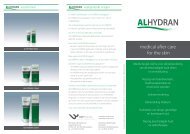You also want an ePaper? Increase the reach of your titles
YUMPU automatically turns print PDFs into web optimized ePapers that Google loves.
Other management techniques include the use ofNPWT. While effective in handling large volumes offluid, they can limit patient movement, require highlevels of expertise, have limited availability in thecommunity and are costly to operate.ConclusionTo perform the sum of absorbency, retention, preventionof maceration, vertical wicking, bioburdenmanagement, MMP modulation and debridement,an amalgamation of technologies specificallydesigned for collective maximum <strong>performance</strong>is required.The efficient management of wounds, especiallyexudate output and its associated chronic inflammation,remains a challenge. However, this can be metif careful consideration is given to the overall woundcharacteristics, <strong>dressing</strong> selection and <strong>dressing</strong> <strong>performance</strong>.Finally, the product must be readilyavailable to clinicians in all health-care sectors at anaffordable unit price, with no hidden costs in theform of extra health-care interventions.References1 Kapadia, H.M. SampsonGamgee: a great BirminghamSurgeon. J R Soc Med 2002;95: 2, 96-100.2 Winter, G. Formation of thescab and the rate ofepithelialization of superfi cialwounds in the skin of theyoung domestic pig. Nature1962; 193: 293-295.3 Forrest, R.D. Early history ofwound treatment. J R Soc Med1982; 75: 3, 198-205.4 Turner, T.D. Semi-occluive andocclusive <strong>dressing</strong>s. In: Ryan, T.J. (ed). An Environment forHealing: The role of occlusion.Royal Society of Medicine,1985.5 Morgan, D.A. The application ofthe ‘ideal <strong>dressing</strong>’ theory topractice. Nursing Scotland1998; July, 16-18.6 Thomas, S. The role of <strong>dressing</strong>sin the treatment of moisturerelatedskin damage. WorldWide <strong>Wound</strong>s, 2008. Availableat: www.worldwidewounds.com/2008/march/Thomas/Maceration-and-the-role-of<strong>dressing</strong>s.htmlAccessed 23February 2010.7 Reddy, M., Kohr, R., Queen, D.et al. Practical treatment ofwound pain and trauma: apatient-centered approach. Anoverview. Ostomy <strong>Wound</strong>Manage 2003; 49: (4 Suppl),2-15.8 van Rijswijk, L. Ingredient-basedwound <strong>dressing</strong> classifi cation: aparadigm that is passé and inneed of replacement. J <strong>Wound</strong>Care 2006; 15: 11-14.9 Trengove, N.J., Stacey, M.C.,Macauley, S. et al. Analysis ofthe acute and chronic woundenvironments: the role ofproteases and their inhibitors.<strong>Wound</strong> Repair Regen 1999; 7:6, 442-452.10 Cutting, K.F. <strong>Wound</strong> exudate:composition and functions. Br JCommunity Nurs 2003; 8:(Suppl. 9), 4-9.11 Bishop, S.M., Walker, M.,Rogers, A.A., Chen, W.Y.Importance of moisturebalance at the wound-<strong>dressing</strong>interface. J <strong>Wound</strong> Care 2003;12: 4, 125-128.12 Broughton, G. 2nd, Janis, J.E.,Attinger, C.E. The basic scienceof wound healing. PlastReconstr Surg 2006; 117:(Suppl. 7), 12S-34S.13 Katz, M.H., Alvarez, A.F.,Kirsner, R.S. et al. Humanwound fl uid from acutewounds stimulates fi broblastand endothelial cell growth. JAm Acad Dermatol 1991; 25:(6 Pt 1), 1054-1058.14 Kennedy, J.F., Bunko, K. Theuse of ‘smart’ textiles forwound care. In: Rajendran, S.(ed). Advanced Textiles for<strong>Wound</strong> Care. WoodheadPublishing, 2009.15 Woodall, R.D. Tissue viability.Living with leg ulcers: apatient’s personal experience.Nurs Stand 1996; 10: 45, 52.16 Lamke, L.O., Nilsson, G.E.,Reithner, H.L. The evaporativewater loss from burns and thewater-vapour permeability ofgrafts and artifi cial membranesused in the treatment of burns.Burns 1977; 3: 3, 159-165.17 Alexander, S. Malignantfungating wounds: managingmalodour and exudate. J<strong>Wound</strong> Care 2009; 18: 9, 374-382.18 Vermeulen, H., Ubbink, D.T.,Goossens, A. et al. Systematicreview of <strong>dressing</strong>s and topicalagents for surgical woundshealing by secondary intention.Br J Surg 2005; 92: 6: 665-672.19 Thomas, S. Alginate <strong>dressing</strong>sin surgery and woundmanagement: part 3. J <strong>Wound</strong>Care 2000; 9: 4, 163-166.20 Snyder, R.J. Managing deadspace: an overview —eliminating these unwantedareas is a key to successfulwound healing. PodiatryManage 2005; 24: 8, 171-174.21 Cochrane, G. The severleydisabled. In: Bader, D.L. (ed.).Pressure Sores: Clinicalpractice and scientifi capproach. Macmillan, 1990.22 White, R.J., Cutting, K.F.Modern exudate management:a review of wound treatments.World Wide <strong>Wound</strong>s, 2006Available at: www.worldwidewounds.com/2006/september/White/Modern-Exudate-Mgt.html Accessed 12December 2009.23 Cutting, K.F., White, R.J.Maceration of the skin andwound bed. 1: Its nature andcauses. J <strong>Wound</strong> Care 2002;11: 7, 275-278.24 Bowler, P.G., Duerden, B.I.,Armstrong, D.G. <strong>Wound</strong>microbiology and associatedapproaches to woundmanagement. Clin MicrobiolRev 2001; 14: 2, 244-269.25 Russell, A.D., Tattawasart, U.,Maillard, J.Y., Furr, J.R. Possiblelink between bacterialresistance and use ofantibiotics and biocides.Antimicrob Agents Chemother1998; 42: 8, 2151.26 Tambe, S.M., Sampath, L.,Modak, S.M. In vitro evaluationof the risk of developingbacterial resistance toantiseptics and antibiotics usedin medical devices. JAntimicrob Chemother. 2001;47: 5, 589-598.27 Bradley, M., Cullum, N.,Sheldon, T. The debridementof chronic wounds: asystematic review. HealthTechnol Assess 1999; 3: 17,iii-iv, 1-78.28 Ma, C., Tarnuzzer, R.W.,Chegini, N. Expression ofmatrix metalloproteinases andtissue inhibitor of matrixmetalloproteinases inmesothelial cells and theirregulation by transforminggrowth factor-beta1. <strong>Wound</strong>Repair Regen 1999; 7: 6, 477-485.29 Chin, G.A., Thigpin, T.G.,Perrin, K.J. et al. Treatment ofchronic ulcers in diabeticpatients with a topicalmetalloproteinase inhibitor,Doxycycline. <strong>Wound</strong>s 2003;15: 10, 315-323.30 Kakagia, D.D., Kazakos, K.J.,Xarchas, K.C. et al. Synergisticaction of protease-modulatingmatrix and autologous growthfactors in healing of diabeticfoot ulcers: a prospectiverandomized trial. J DiabetesComplications 2007; 21: 6,387-391.31 Vin, F., Teot, L., Meaume, S.The healing properties ofPromogran in venous legulcers. J <strong>Wound</strong> Care 2002;11: 9, 335-341.32 Horken, L., Stansfi eld, G.,Miller, M An analysis ofsystematic reviews undertakenon standard advanced wound<strong>dressing</strong>s in the last 10 years. J<strong>Wound</strong> Care 2009; 18: 7,298-304.33 Metzger, S. Clinical and fi nancialadvantages of moist woundmanagement. Home HealthcNurse 2004; 22: 586-590.34 Vowden, K., Vowden, P.Understanding exudatemanagement and the role ofexudate in the healing process.Br J Comm Nurs 2003; 8: 11(Suppl), 4-13.All <strong>dressing</strong>s should bechanged in line with themanufacturer’s instructionsfor use and clinicians shouldbe pragmatic about<strong>performance</strong> expectationsJ O U R N A L O F W O U N D C A R E S O R B I O N S U P P L E M E N T 2 0 1 09



